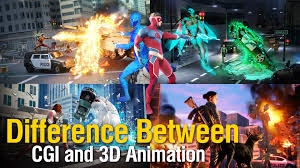CGI and 3D Ads: Understanding the Differences and Benefits
In the digital age, advertising has evolved dramatically, with advanced technologies enabling brands to create captivating and immersive experiences. Among these technologies, CGI (Computer-Generated Imagery) and 3D ads stand out for their ability to produce stunning visuals and enhance viewer engagement. While these terms are often used interchangeably, they refer to distinct approaches with unique benefits. Here’s a detailed look at the differences between CGI and 3D ads and how each can benefit your advertising strategy.

What is CGI?
CGI, or Computer-Generated Imagery, encompasses a broad range of digital visuals created using computer software. This includes both 2D and 3D images and animations. CGI is used across various industries, including advertising, film, video games, and virtual simulations, to create everything from realistic product visuals to imaginative scenes.
Key Aspects of CGI:
- Versatility: CGI includes a wide spectrum of visual techniques, including 2D graphics, 3D models, and animated sequences.
- Applications: Utilized for product visualizations, architectural renderings, and detailed animations.
- Flexibility: Offers control over all visual elements, including textures, lighting, and environments.
What are 3D Ads?
3D ads specifically utilize three-dimensional graphics to create dynamic, interactive visual content. This approach involves constructing detailed 3D models and scenes that provide a realistic sense of depth and space. 3D ads are particularly effective for showcasing products in a more engaging and lifelike manner.
Key Aspects of 3D Ads:
- Depth and Realism: Offers a realistic portrayal with spatial awareness, enhancing viewer engagement.
- Interactivity: Often used in interactive ads, such as augmented reality (AR) and virtual reality (VR), allowing users to explore and interact with the content.
- Dynamic Visualization: Ideal for demonstrating products in different contexts and from various angles.
Comparing CGI and 3D Ads
1. Scope and Definition
- CGI: A broad term that encompasses all computer-generated visuals, including both 2D and 3D content.
- 3D Ads: A specific application of CGI focused on creating three-dimensional visuals and animations.
2. Visual Complexity
- CGI: Can range from simple 2D graphics to complex 3D animations, offering a wide array of visual effects.
- 3D Ads: Focused on detailed 3D modeling and rendering, providing a higher level of realism and depth.
3. Interactivity
- CGI: Can include both static and dynamic content, with potential for interactive elements depending on the project.
- 3D Ads: Often designed for interactive experiences, allowing users to engage with the content in a more immersive way.
4. Cost and Production
- CGI: Production costs can vary widely based on the complexity of the visuals and whether the content is 2D or 3D.
- 3D Ads: Typically involve higher production costs due to the detailed 3D modeling and rendering required, but offer significant engagement potential.
5. Application and Use Cases
- CGI: Versatile applications across different media, including static and animated ads, film, and virtual simulations.
- 3D Ads: Particularly effective for product demonstrations, interactive ads, and immersive brand experiences.
Benefits of CGI
1. Creative Flexibility: Allows for the creation of both realistic and imaginative visuals tailored to specific needs. 2. Cost-Effective: Can be more economical than traditional methods, especially for complex or fantastical scenes. 3. Detailed Customization: Offers precise control over visual elements, ensuring alignment with brand identity.
Benefits of 3D Ads
1. Enhanced Realism: Provides a more lifelike and engaging portrayal of products and environments. 2. Interactivity: Ideal for creating interactive and immersive advertising experiences. 3. Dynamic Presentation: Allows for detailed and versatile product demonstrations from various angles and contexts.

Conclusion
Both CGI and 3D ads offer valuable tools for creating impactful and engaging advertising content. While CGI provides a broad range of creative possibilities, 3D ads deliver enhanced realism and interactivity, making them ideal for immersive and dynamic brand experiences. Depending on your advertising goals and the type of content you wish to produce, leveraging either or both techniques can help you capture attention and achieve your brand objectives.
Interested in exploring CGI or 3D ads for your next campaign? Contact MyHoardings to learn more about how we can bring your vision to life.
- Email: business@myhoardings.com
- Phone: +91-9953847639
- Website: www.myhoardings.com
Feel free to reach out for further assistance or to discuss how CGI and 3D ads can enhance your advertising strategy!
Brand Promotion options in Cinema Halls
India’s TOP Sports Associations and Events |



